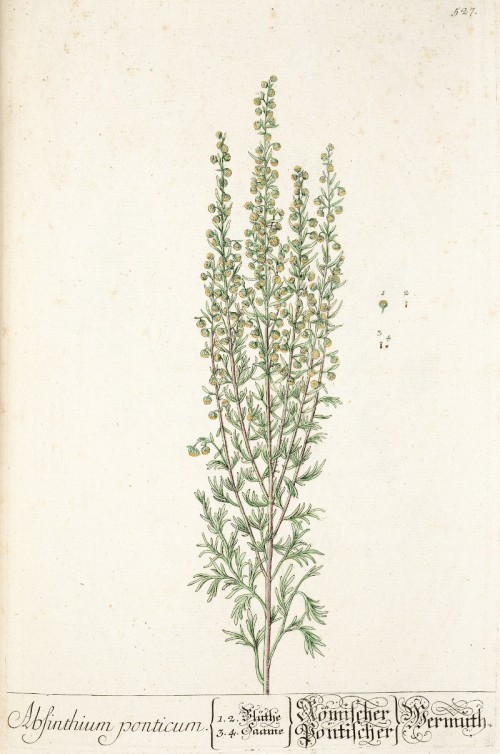Artemisia afra Jacq. ex Willd. - syn.Absinthium ponticum (L.) Garsault] - Asteraceae
African wormwood, Afrikanischer Wermut, Pontischer Wermut, Römischer Wermut
Bushy shrub, up to 2m high, native to southern Africa; leaves 2-pinnatipartite, ultimate segments linear, glabrous above, canescent beneath, margin entire or toothed; capitula many in terminal racemose panicles, flowers yellow. http://www.zimbabweflora.co.zw/speciesdata/species.php?species_id=160890
„Artemisia afra is a well-known medicinal plant in Africa, and is still used by people of many cultures. The roots, stems and leaves are used as enemas, poultices, infusions, lotions, inhaled (e.g. smoked or snuffed), or as an essential oil. In addition, Artemisia afra is frequently used as a moth repellent, and in organic insecticidal sprays.“ http://en.wikipedia.org/wiki/Artemisia_afra
„It has been shown that statistically significant higher oil yields could be obtained from Artemisia afra when the plants were harvested during anthesis and early seed set. The chemical composition of four generations of the same clone was found to be very constant. On examination of the oil composition of wild populations of A. afra, the existence of chemotypes was revealed. Oils rich in 1,8-cineole (50.14%), α-thujone (74.91–75.28%), β-thujone (21.49–22.44%), and camphor (27.92%) were found.“
[The Development of Artemisia afra (Jacq.) as a New Essential Oil Crop, Graven, EH, Webber, L, Venter, M, Gardner, JB, Journal of Essential Oil Research, Vol.2(5), 1990, 215-220]
„Steam-distilled volatile oil from Artemisia afra Jacq. (family Compositae), indigenous to the mountainous regions in southern Africa and used in popular medicine, was analysed by gas chromatography and tested for antimicrobial and antioxidative properties. The main components of the volatile oil were α- and β-thujone (52%), 1,8-cineole (13%), camphor (15%) and α-pinene (2%). Twenty-five bacterial species and three filamentous fungi were used to assess the antimicrobial properties. Fifteen test bacteria and one fungus showed high degree of inhibition of growth caused by the volatile oil. The most susceptible organisms were Acinetobacter calcoaceticus, Beneckea natriegens, Brevibacterium linens, Brochothrix thermosphacta, Citrobacter freundii, Klebsiella pneumoniae and Serratia marcescens. The oil exerted considerable antioxidative effect.“
[Antimicrobial and antioxidative properties of the volatile (essential) oil of Artemisia afra (Joaq)., Graven, E.H., Deans, S.G., Svoboda, K., Mavi, S., Gundidza, M.G., Flavour and Fragrance Journal, Vol.7, 1992, 121-123]
„Artemisia afra oil had a higher α-thujone and a lower 1,8-cineole content than that reported by Graven et al. (1992) and the oil did not contain any camphor. The differences can probably be attributed to the different genotypes of the plant material used (Graven et al. 1990).“ Main components of the essential of of A.afra were α-thujone (78%), β-thujone (13%) and 1,8-cineole (8%).
[Comparative evaluation of the antimicrobial activities of essential oils of Artemisia afra, Pteronia incana and Rosmarinus officinalis on selected bacteria and yeast strains. Mangena, T., Muyima, N. Y. O., Letters in applied microbiology, Vol.28(4), 1999, 291-296]
http://onlinelibrary.wiley.com/doi/10.1046/j.1365-2672.1999.00525.x/full
„Medicinal uses:
Internal: For the treatment of cough, croup, whooping cough, influenza, fever, diabetes, gastro-intestinal disorders and intestinal worms.
External: As an inhalation for the relief of headache and nasal congestion or a lotion to treat haemorrhoids. In traditional practice, fresh leaf is inserted into the nostrils to relieve nasal congestion or placed in boiling water as a steam bath for menstrual pain or after childbirth. Warmed leaves may be applied externally as a poultice to relieve inflammation and aqueous infusions administered per rectum or applied as a lotion to treat haemorrhoids.“
http://www.turner.ukzn.ac.za/sites/default/files/Artemisia_Afra_rev.pdf

Blackwell,E., Herbarium Blackwellianum, vol.6 t.527 (1773)
http://plantgenera.org/species.php?id_species=91196
